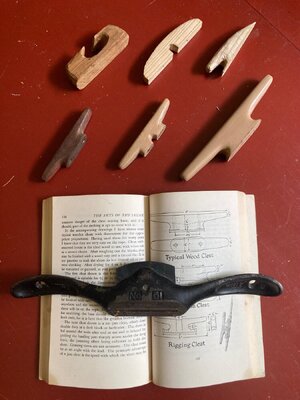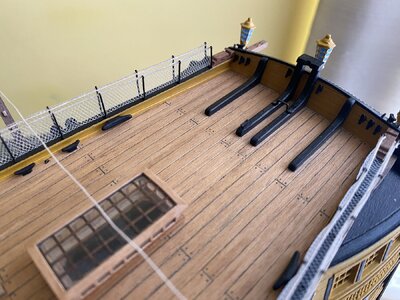When you are making cleats(those that do) do you worry a lot about the grain of the wood? It's a lot faster to pre shape a stick and then saw the cleats off the end. I have a very strong wood that I think would take the strain but I'm not that sure about it.
-
LUCZORAMA SHIPWRECK SCAVENGER HUNT GIVEAWAY. 4 Weeks of Fun • 1 Legendary Prize ((OcCre’s Fram Ship)) • Global Crew Welcome!
**VIEW THREAD HERE**
You are using an out of date browser. It may not display this or other websites correctly.
You should upgrade or use an alternative browser.
You should upgrade or use an alternative browser.
So yours are end grain? What kind of wood do you use and have you had any trouble with breakage?
Hard maple slicing the cleats (down as much as about 1 mm) against the grain.
Hi, Don. I remembered now. I did not make them as I described above. Sorry. Actually I took hard maple plank (as 1 x 2.5 mm). I sliced it into rectangles. I glued them all together into a bar with a very tiny speck of PVA glue so I can split them later. Bar consisted of 8 rectangles. If I glued together more they fell apart when carving. I carved the bar into cleat shape. Then I split it. Each cleat was then filed around to make it a proper shape.
Last edited:
That's what I'm finding for cleats. I also drill a hole from top to bottom and put in a piece of bamboo to mount them and strengthen the edge grain part. For the ribs of parrels I can get away with edge grain.
Last edited:
I just took another look at this. You made very nice cleats.
I've whittled a number of cleats, fairleads, and chocks for full-sized (but small) boats. In his book "The Arts of the Sailor," Hervey Garrett Smith provides very useful information on making and using cleats. The tricky part of making cleats for model watercraft comes down to, like almost every aspect of model making, a single word: scale. Carving a cleat for a boat model of 1:12 scale is very doable. At 1:500, only the largest cleat can be reproduced. While we as model makers deal with the realities of scale constantly, we seldom discuss it. Miniatures do not exist outside the laws of physics. The scale of a model dictates the degree of detail possible. Fair winds!





